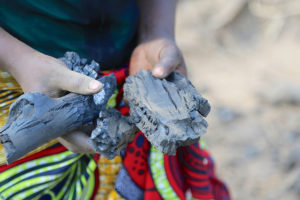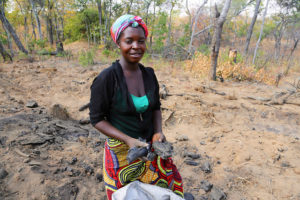
Women’s involvement in the traditionally male-dominated charcoal industry is increasing across Zambia.
Following an earlier story in which 27-year-old Mabvuto Zulu shared her experiences producing charcoal in Zuwalinyenga village in eastern Zambia, recent findings from the Center for International Forestry Research (CIFOR) have shown that Mabvuto is far from being alone as a woman in charcoal production and trade.
While anyone visiting a charcoal market in Lusaka would be able to witness a good number of women working as traders and retailers, discussions conducted in the charcoal-producing districts of Choma and Monze in southern Zambia reveal that it has also become increasingly common for women to engage in stages of production. This can include everything from packaging charcoal to molding kilns, and even felling and cutting trees.
The increased involvement of women is attributed to an increase in demand (particularly boosted by load shedding arrangements in major cities) as well as a perceived increase in poverty in rural areas. Many women view charcoal production and trade as a viable business opportunity with low entry barriers. Trees growing on what is seen as ‘no-man’s land’, such as national forest reserves, are generally easy to access, and capital requirements for producing charcoal tend to be low.
At the same time, some women feel pushed into charcoal production due to poverty and a lack of viable alternative livelihood options. This is aggravated by fluctuating rainfall patterns, which negatively affect crop yields. Despite the viability of charcoal, most women and men still view farming, not charcoal production, as their primary source of livelihood.
When asked about how income from charcoal is spent, most respondents mention various one-off expenses, such as school fees or agricultural inputs. Others, particularly widowed or divorced women, emphasize the income security that charcoal can provide when crops fail. Charcoal income thus plays an important complementary – rather than competing – role with other income sources.
Watch: The State of Charcoal Production in Zambia

ON EQUAL FOOTING?
While more women are getting involved in charcoal production and trade, their level of involvement is often differentiated by marital status.
Unmarried, widowed or divorced women are involved throughout the production cycle, while most married women say they generally play a supportive role to their husbands, sticking to activities perceived as ‘more suitable for women’.
These kinds of jobs include packaging and selling charcoal, which are perceived as less physically demanding and easier to combine with childcare and other reproductive responsibilities.
Of the limited number of married women involved in production, many reported their husband’s illness or alcohol abuse as the reason for their engagement. Indeed, our discussions show that if a married woman is involved in charcoal production, others may perceive it as a sign of the husband being unable to provide for the family. This presents an additional potential entry barrier to married women, as women or their husbands may wish to avoid such social stigma.
While some charcoal is sold in local markets, many women opt to bring their products to urban markets, where they can receive higher prices. Both women and men seem to believe that women are more honest and responsible than their male counterparts, hence women are believed to make good traders. Many charcoal producers – both men and women – also prefer to sell their charcoal to female traders.
The physical nature of many activities associated with charcoal production certainly plays a role in shaping ideas of what is and isn’t suitable for women. Many female charcoal producers complain that the work is very strenuous. To manage, some women work in teams of six or more, while others rely on hired labor. While the employment opportunities are appreciated, particularly by younger men, such arrangements of course cut women’s profit margins.
Women’s reliance on male labor also makes them vulnerable to exploitation. Some women complain that the men they hire to help tend to use up the money before the job is done. Others reveal that some charcoal transporters request sexual favors as ‘in-kind payments’ if the women are unable to pay the demanded price for transporting the charcoal to urban markets.
Read also: Wood fuel in the climate pledges of countries in Sub-Saharan Africa
CHANGING NORMS?
Should women’s entry into a traditionally male-dominated field be seen as a sign of changing gender norms? While most women report feeling pushed into charcoal production due to poverty, many are also proud to show that they can do what men do. Many married women also say that their involvement in charcoal production and trade has gained them more equal control over income.
In this sense, our findings seem to mirror the situation in Zambia’s Copperbelt, where growing economic insecurity is encouraging an increasing number of women to move into the mining sector. Findings from a recent study show that while many men historically opposed their wives going out to work, they are now applauding strong women who fend for their families and are doing what was previously seen as beyond their capabilities.
However, while most men report a general acceptance of women’s involvement in charcoal production due to the dire economic circumstances, they are not always happy about it. Some men complain that women who earn income from charcoal have become disrespectful to their husbands, while others bemoan that women now spend less time taking care of their families. Some also suspect that women are engaging in extramarital affairs when they are away from home in Lusaka selling charcoal. Women’s involvement in charcoal production and trade is thus seen as ‘home-wrecking’, and some women are said to have already lost their husbands over it.

While charcoal production and trade offers women higher incomes, greater autonomy and a sense of pride, many women are also paying a high social price for upsetting a patriarchal system – this despite the fact that both women and men view women’s increased involvement primarily as an inevitable result of poverty!
To add to the irony, many women note that rampant charcoal production is resulting in a loss of fruit trees and trees good for caterpillar harvesting, both of which are important alternative income sources, particularly for female-headed households, according to another study.
FINDING A WAY FORWARD
So, what do the findings tell us? First, they caution against simplistic interpretations of women’s involvement in charcoal production as a sign of changed gender norms and women’s empowerment. By engaging in traditionally male-dominated activities and earning an independent income, women like Mabvuto are certainly challenging gendered divisions of labor. Hopefully, women’s entry into charcoal production can also contribute to the process of transforming unequal gender norms and power relations in rural Zambia.
However, this process is currently facing a strong patriarchal backlash in the form of exploitation and stigmatization of charcoal-producing women.
Second, and on a related point, policymakers who care about gendered impacts should be aware that policies and regulations that directly or indirectly increase production costs may disproportionately affect female producers, as they rely to a greater degree on hired labor and hence have lower profit margins. Such impacts may be particularly detrimental given that many female producers are widows or divorcees, and therefore the sole breadwinners of their households.
Third, our findings demonstrate a need for more intersectional approaches to unpacking the social dynamics of the charcoal value chain. The opportunities and challenges that women are facing are certainly structured by unequal gender norms and power relations. As we have seen, these are often intertwined with other social factors, such as age and marital status, and vary depending on one’s location along the value chain.
By Markus Ihalainen, Muzione Christina Mwale, Kaala Moombe and Davison Gumbo, originally published at CIFOR’s Forests News.
For more information on this topic, please contact Markus Ihalainen at m.ihalainen@cgiar.org.
This research forms part of the CGIAR Research Program on Forests, Trees and Agroforestry, which is supported by CGIAR Fund Donors.
This research was supported by UK aid from the UK government.











